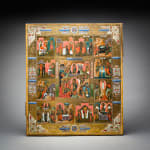The Resurrection and Descent into Hell, 18th Century CE - 19th Century CE
Tempera on Wood
height 35.6 cm
height 14 in
height 14 in
PF.5707
Inseparable from the liturgical tradition, religious art functions as a form of pictorial confession of faith and a channel of religious experience for Orthodox Christians. Because icons were believed to...
Inseparable from the liturgical tradition, religious art functions as a form of pictorial confession of faith and a channel of religious experience for Orthodox Christians. Because icons were believed to provide direct personal contact with the holy persons represented on them, these images were objects of veneration, in either a public or private setting or during travels, and were also thought to have the ability to heal.
The central panel depicting the Resurrection of Christ and the Descent into Hell is surrounded by twelve smaller panels depicting twelve major church festivals. These are as follows, starting from the upper left and moving clockwise: the Nativity of the Virgin, the Presentation of the Virgin at the Temple, the Annunciation, the Nativity of Christ, The Baptism of Christ, the Transfiguration of Christ, the Dormition of the Virgin, the Elevation of the Cross, the Old Testament Trinity, The Ascension of Christ, the Entry into Jerusalem, and the Presentation of Christ at the Temple. An engraved foliate border surrounds these scenes. Together, this spectacular icon represents the central theme of Christianity in the midst of the most important events in the life of the Virgin and Christ. Most impressive is how much iconography the painter managed to squeeze into such a tight space while still managing to keep everything clear and comprehensible. Painted with stunning detail and minute ascents throughout, this icon is a true work of beauty that glows when the light shines against its luminous gold leaf background.
The central panel depicting the Resurrection of Christ and the Descent into Hell is surrounded by twelve smaller panels depicting twelve major church festivals. These are as follows, starting from the upper left and moving clockwise: the Nativity of the Virgin, the Presentation of the Virgin at the Temple, the Annunciation, the Nativity of Christ, The Baptism of Christ, the Transfiguration of Christ, the Dormition of the Virgin, the Elevation of the Cross, the Old Testament Trinity, The Ascension of Christ, the Entry into Jerusalem, and the Presentation of Christ at the Temple. An engraved foliate border surrounds these scenes. Together, this spectacular icon represents the central theme of Christianity in the midst of the most important events in the life of the Virgin and Christ. Most impressive is how much iconography the painter managed to squeeze into such a tight space while still managing to keep everything clear and comprehensible. Painted with stunning detail and minute ascents throughout, this icon is a true work of beauty that glows when the light shines against its luminous gold leaf background.



